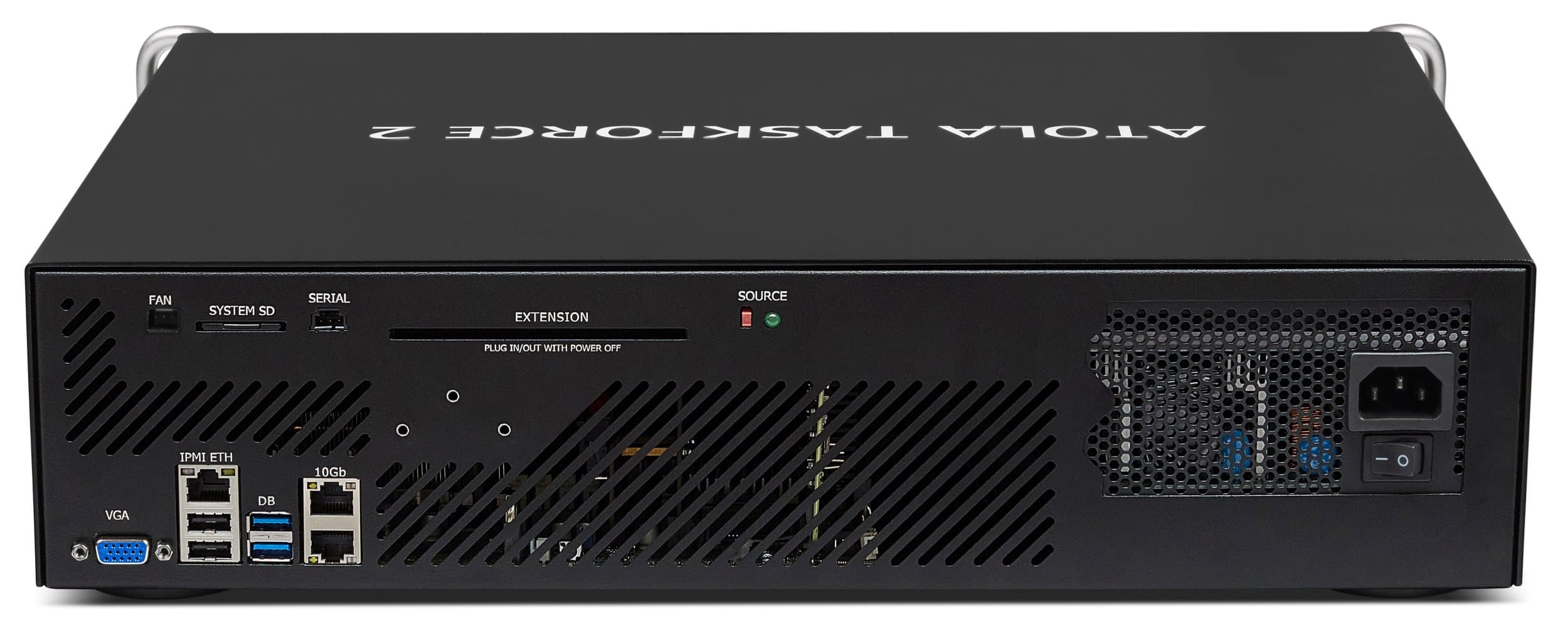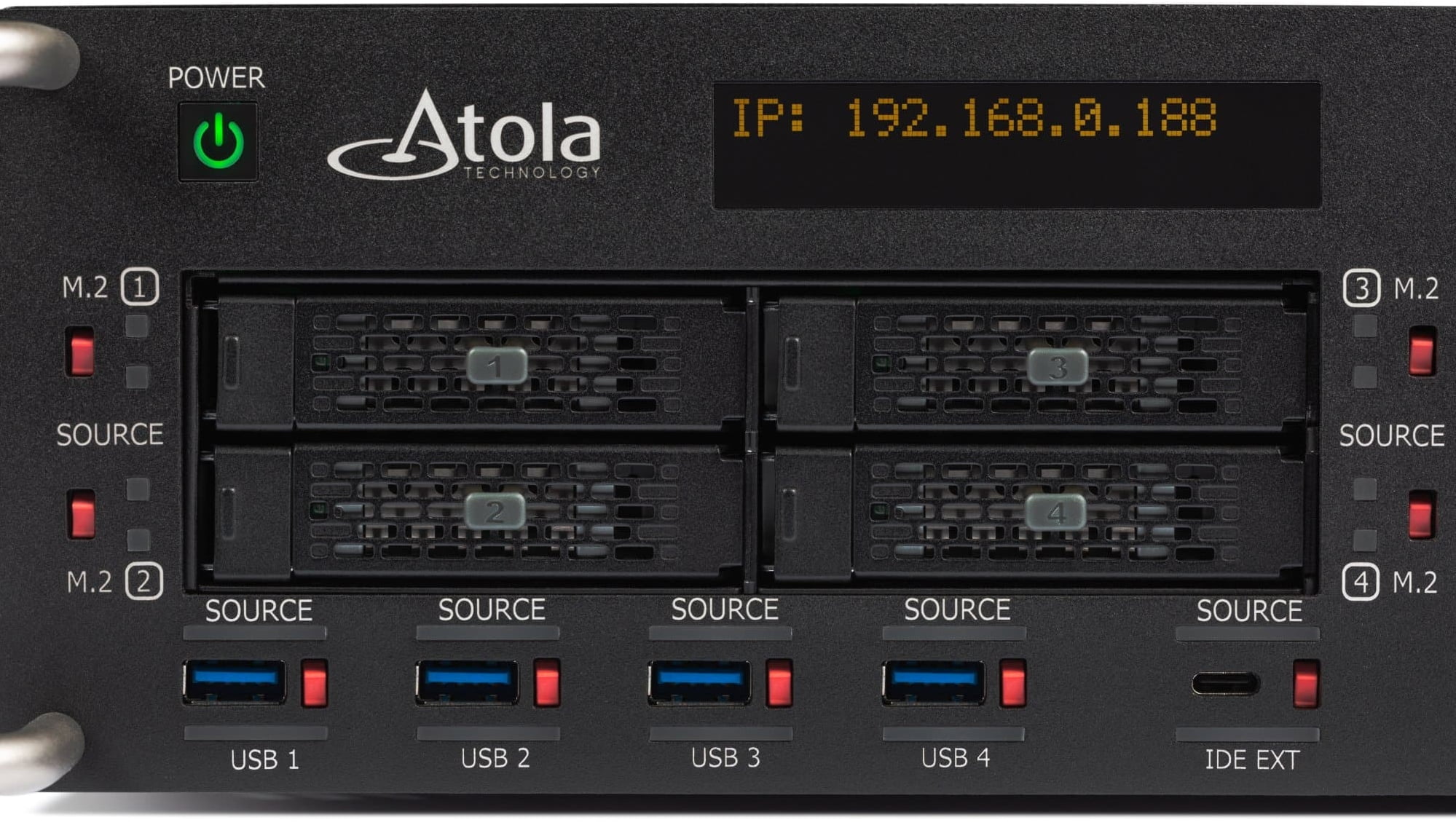Forensic hardware unit
To support many simultaneous imaging sessions and other forensic tasks running on its 26 ports at top speeds, TaskForce 2 hardware unit is built on extremely robust, high-capacity components that include a server-grade motherboard, 16-thread Xeon CPU and 16 GB ECC RAM. To ensure the high quality and efficiency of our tools, we test them on hundreds of storage devices.
This forensic hardware unit is designed for various types of digital investigations in the lab environment.
Ports, indicators & switches
Ports:
- 8 SATA
- 8 SATA/SAS
- 4 USB 3.0
- 4 NVMe M.2/U.2 PCIe 4.0
- IDE
- Extension slot (for Thunderbolt, Apple PCIe SSD and M.2 SSD extension modules)
Source/target switch on each of 26 ports enabling hardware write protection in source mode:
- Source mode: helps safely connect and with the examined evidence drives to TaskForce 2.
- Flexible port configuration: any TaskForce port can serve you as a source or target depending on your needs.
LED indicators: two indicators for each of the 26 ports. One indicator is located next to the port’s source/target switch and lights up when source mode is enabled.
There are plenty of informative LED indicators on the front panel of the unit:
- Power LED indicator to signal that hardware is up and running.
- IP display to show an IP address you need to connect to the TaskForce 2 control interface using Chrome browser.
- White LED source/target indicator on each of the 26 ports to quickly check if the port is in the source mode and the drive is write-protected.
- Color-coded LED indication of each port status:
- Green light: the task is completed successfully.
- Yellow light: the task completed with minor issues or warnings.
- Red light: the task failed.
- Blue light: the connected drive is in Storage mode.
- LED lights still: the task is finished.
- LED is blinking: the task is running.
You can even control LED brightness and color in TaskForce 2 settings.
Network ports:
- Two 10Gb Ethernet ports handle 26 multiple imaging sessions utilizing two 10Gb network connections
- One IPMI ETH port
Other connections:
- Two USB 3.0 ports for connecting a USB flash media as TaskForce 2 database storage
- Two USB 2.0 ports for keyboard/mouse in the Kiosk mode
- VGA for connecting a monitor in the Kiosk mode
- Auxiliary serial RS232 port
- Auxiliary fan power port
The power socket is located on the back side of the unit.
Supported hard drive interfaces: SATA I/II/III, SAS3 (12Gb), USB 2.0/3.0, IDE, M.2/U.2 PCIe NVMe up to 4.0.
Flash memory cards are supported via a card reader plugged into any USB port of TaskForce 2.
Display
IP display: OLED (20x2 characters)
Physical / Environmental
- Dimensions: 17.4 × 14.5 × 3.9 in (442 × 370 × 100 mm)
- Weight: 17.2 lb (7.8 kg)
- Working temperature range: 32° – 95°F (0°C – 35°C)
- Power consumption: 140 Watt average, 650 Watt peak
- Supply Voltage: 100–240 VAC, 50–60 Hz
- RoHS compliant
Other specs
- Internal OS: Linux running a custom kernel
- Control interface: web-based TaskForce application
- Removable NVMe SSD for internal case management database
- Optional WiFi 802.11n 150 Mb/s adapter in access point mode for easy connectivity (purchased separately)
Inside TaskForce forensic hardware unit
TaskForce 2 forensic hardware unit is essentially a small server-grade computer running Linux. But because neither BIOS nor Linux kernel was designed to handle hard disk failures, Atola engineers have invested a significant amount of research and development efforts to build a highly customized and fine-tuned Linux kernel that fully overcomes these issues and handles damaged media properly. Additionally, this kernel features:
- High-speed DMA data transfers, 500+ MB/s
- Full low-level control over SATA, USB and IDE ports
- Full native SATA support
- Reset and SATA PHY control for best handling of severely damaged hard drives
- All BIOS and standard kernel functions are disabled
TaskForce 2 hardware also features Atola's proprietary circuitry for the ultimate drive's power control:
- Current sensor for in-depth hard disk diagnosis
- Automatic overcurrent and short-circuit protection
- Overvoltage protection
These features are a must for proper handling of damaged drives.
For instance, low-level control of the SATA, SAS, USB and IDE ports allows TaskForce 2 to handle the devices that do not properly initialize, have many bad sectors, or frequently freeze due to internal (mechanical) failures. SATA PHY control allows resetting a frozen hard drive without a power cycle, thus saving time during imaging, and reducing the chances of further hard disk degradation and failure. Current sensing allows TaskForce to diagnose a failed drive even if it has electronic or mechanical damage.
Overcurrent protection detects when the drive draws an abnormal current and stops it to prevent any further damage. An overvoltage protection circuit ensures that in the unlikely event of a hardware malfunction, the attached drives are not damaged in any way.
TaskForce 2 forensic hardware unit is fully controlled by the software via Chrome browser, therefore no Linux experience is required to operate it.




